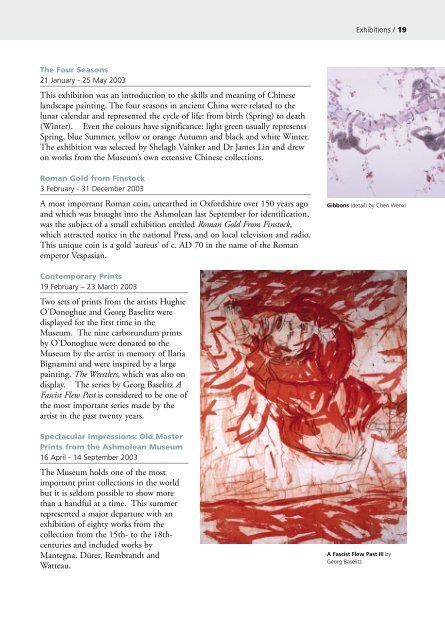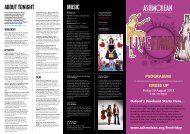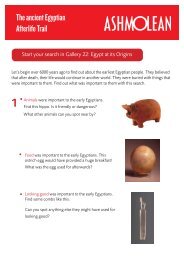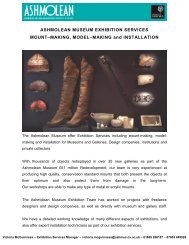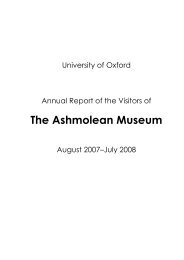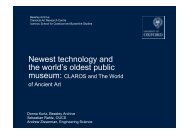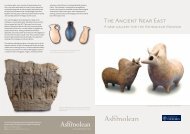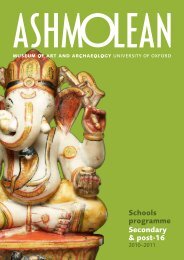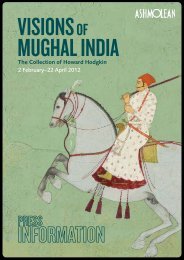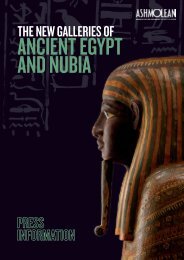Highlights of the Annual Report - The Ashmolean Museum
Highlights of the Annual Report - The Ashmolean Museum
Highlights of the Annual Report - The Ashmolean Museum
You also want an ePaper? Increase the reach of your titles
YUMPU automatically turns print PDFs into web optimized ePapers that Google loves.
Exhibitions / 19<br />
<strong>The</strong> Four Seasons<br />
21 January - 25 May 2003<br />
This exhibition was an introduction to <strong>the</strong> skills and meaning <strong>of</strong> Chinese<br />
landscape painting. <strong>The</strong> four seasons in ancient China were related to <strong>the</strong><br />
lunar calendar and represented <strong>the</strong> cycle <strong>of</strong> life: from birth (Spring) to death<br />
(Winter). Even <strong>the</strong> colours have significance: light green usually represents<br />
Spring, blue Summer, yellow or orange Autumn and black and white Winter.<br />
<strong>The</strong> exhibition was selected by Shelagh Vainker and Dr James Lin and drew<br />
on works from <strong>the</strong> <strong>Museum</strong>’s own extensive Chinese collections.<br />
Roman Gold from Finstock<br />
3 February - 31 December 2003<br />
A most important Roman coin, unear<strong>the</strong>d in Oxfordshire over 150 years ago<br />
and which was brought into <strong>the</strong> <strong>Ashmolean</strong> last September for identification,<br />
was <strong>the</strong> subject <strong>of</strong> a small exhibition entitled Roman Gold From Finstock,<br />
which attracted notice in <strong>the</strong> national Press, and on local television and radio.<br />
This unique coin is a gold ‘aureus’ <strong>of</strong> c. AD 70 in <strong>the</strong> name <strong>of</strong> <strong>the</strong> Roman<br />
emperor Vespasian.<br />
Gibbons (detail) by Chen Wenxi<br />
Contemporary Prints<br />
19 February – 23 March 2003<br />
Two sets <strong>of</strong> prints from <strong>the</strong> artists Hughie<br />
O’Donoghue and Georg Baselitz were<br />
displayed for <strong>the</strong> first time in <strong>the</strong><br />
<strong>Museum</strong>. <strong>The</strong> nine carborundum prints<br />
by O’Donoghue were donated to <strong>the</strong><br />
<strong>Museum</strong> by <strong>the</strong> artist in memory <strong>of</strong> Ilaria<br />
Bignamini and were inspired by a large<br />
painting, <strong>The</strong> Wrestlers, which was also on<br />
display. <strong>The</strong> series by Georg Baselitz A<br />
Fascist Flew Past is considered to be one <strong>of</strong><br />
<strong>the</strong> most important series made by <strong>the</strong><br />
artist in <strong>the</strong> past twenty years.<br />
Spectacular Impressions: Old Master<br />
Prints from <strong>the</strong> <strong>Ashmolean</strong> <strong>Museum</strong><br />
16 April - 14 September 2003<br />
<strong>The</strong> <strong>Museum</strong> holds one <strong>of</strong> <strong>the</strong> most<br />
important print collections in <strong>the</strong> world<br />
but it is seldom possible to show more<br />
than a handful at a time. This summer<br />
represented a major departure with an<br />
exhibition <strong>of</strong> eighty works from <strong>the</strong><br />
collection from <strong>the</strong> 15th- to <strong>the</strong> 18thcenturies<br />
and included works by<br />
Mantegna, Dürer, Rembrandt and<br />
Watteau.<br />
A Fascist Flew Past III by<br />
Georg Baselitz


